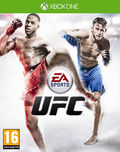You can trust VideoGamer. Our team of gaming experts spend hours testing and reviewing the latest games, to ensure you're reading the most comprehensive guide possible. Rest assured, all imagery and advice is unique and original. Check out how we test and review games here
Still desperate for that true ‘next-gen’ experience? You’re not alone. As the months have passed since release there’s really not been that much to help justify your investment in what is now the current generation. There’s a high-chance, however, that (visually speaking at least) EA Sports UFC may do the job.
The first game to bear the Ultimate Fighting Championship license since THQ said goodbye last year, EA has seemingly taken the power it possessed when Fight Night: Round 3 took over the Xbox 360 all those years ago and tried to replicate it. It’s not until you actually sit down with it, mind, that you actually see just how accomplished it is.
Aside from the way the character models move and look – and they are by far some of the best I’ve ever seen – it’s the numerous small touches EA has worked in that shifts this out of the realm of what we expect, and into a world that’s only possible on ‘new’ consoles. Lights reflect off fighters’ eyes (much as they do in the real world), you can see individual bones moving in their feet, limbs contort as they smack against an opponent’s flesh. It all comes together for an incredibly realistic-looking experience.
Aesthetics aside, the core game itself also adheres to this standard of realism. As with any game that tries to convert the art of MMA to a video game though, the sport’s complicated nature must be addressed intelligently. There’s an instant accessibility where two people are just duking it out, but there are numerous other facets that have to be taken into account: guards, clinches, submissions, the ground game. If it all doesn’t seamlessly fit together, one of the sport’s major selling points is ripped away.
Currently, EA is handling most of it well. With two fighters standing toe-to-toe, you get the kind of setup you’d expect. Punches and kicks with are assigned to the face buttons, with modifiers and the ability to enter a clinch or take your rival down being assigned to the triggers and/or the right analogue stick. There’s still a learning curve here, and anyone wanting to explore the game’s depths is going to have to put in some time. Thankfully the logic of the control setup is sound – changing guard when you have managed to ground someone, for example, is done by moving the stick as if you were actually in control of a fighter’s body; it makes more sense the more time you spend with it.
It’s enjoyable to play, too. If you do decide to just slug it out the bruises and blows are satisfying and, if you time it right, as devastating as they should be. Allow yourself to be taken in further and the potentially available tactics – and your satisfaction in making them work – opens up immensely. On the other hand, you’ll need a working knowledge of the sport to get the most out of it, and whether the game can be structured to the point where ‘anyone’ can enjoy EA Sports UFC remains questionable. The longevity comes from understanding how the entire thing works. This isn’t the same as a Fight Night where you can get a lot out of it just by hurling haymakers and hooks.
In many ways, it’s the step up and extension of EA’s previous effort, ‘MMA’. All the smaller details have been increased, but the similarities are there. One big change, and a constant challenge for anyone who has tackled the matter, is the submission game. While others have opted for the standard ‘Track and Field mash button’ technique, EA has invented its own mini-game (although there are nods towards UFC 3’s equivalent) to try and replicate the sensation of both applying a lock and trying to evade it.
As soon as an attempt is made, whoever is on the offensive will have button prompts flash up on a grid-like system asking them to flick the left stick in a particular direction. At the same time, however, the defendant is pushing the right stick either up, down, left, or right to try and fill up one of the four gauges on-screen and escape. The only way to stop this from happening is to counteract it by also pushing in the same direction. It all equates to a back and forth challenge where the aggressor has to both stop a potential counter and keep their eye out for the QTE which will enable them to proceed in their mission to tap some fool out.
In fairness, it’s far harder to describe than it is to actually get to grips with when the pad is in hand, but there’s bound to be some question marks raised. While I found it to be highly entertaining – the core concept is essentially that of cat and mouse – it takes away the sudden impact of executing a move and ending a fight within seconds. Admittedly skill levels will determine how quickly you can succeed at it, but it stands to reason that two experienced players would never get that immediate thrill.
UFC is shaping up to be a good fighting game, but considering purists are surely the major demographic EA is going for, a few inconsistencies may irk such an audience. Be it the somewhat streamlined transitions that are on offer, or the inauthentic moves that can triggered from certain positions, it’s not quite as detailed as some would like it. Which, in fairness, won’t be a huge blow to most, and the game itself has plenty of potential. Whether it can grab mass-market interest is the real question: the THQ games, sales-wise, decreased with each iteration. It’s a trend EA will be hoping to buck.
EA Sports UFC
- Platform(s): PlayStation 3, PlayStation 4, Xbox 360, Xbox One
- Genre(s): Sport

